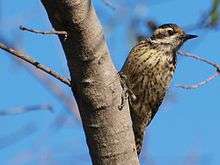Checkered woodpecker
The checkered woodpecker (Veniliornis mixtus) is a woodpecker (Family Picidae) found in eastern South America.
| Checkered woodpecker | |
|---|---|
 | |
| Female in Buenos Aires, Argentina | |
| Scientific classification | |
| Kingdom: | Animalia |
| Phylum: | Chordata |
| Class: | Aves |
| Order: | Piciformes |
| Family: | Picidae |
| Genus: | Veniliornis |
| Species: | V. mixtus |
| Binomial name | |
| Veniliornis mixtus (Boddaert, 1783) | |
| Synonyms | |
|
Picoides mixtus | |
Taxonomy
The checkered woodpecker was described by the French polymath Georges-Louis Leclerc, Comte de Buffon in 1780 in his Histoire Naturelle des Oiseaux from a specimen collected in Buenos Aires, Argentina.[2] The bird was also illustrated in a hand-coloured plate engraved by François-Nicolas Martinet in the Planches Enluminées D'Histoire Naturelle which was produced under the supervision of Edme-Louis Daubenton to accompany Buffon's text.[3] Neither the plate caption nor Buffon's description included a scientific name but in 1783 the Dutch naturalist Pieter Boddaert coined the binomial name Picus mixtus in his catalogue of the Planches Enluminées.[4] The checkered woodpecker is now placed in the genus Veniliornis that was introduced by the French ornithologist Charles Lucien Bonaparte in 1854.[5][6] The generic name combines the name of the Roman deity Venilia with the Ancient Greek word ornis meaning "bird". The specific epithet mixtus is the Latin word for "mixed" or "jumbled".[7]
This species was until recently classified in the genus Picoides. With its sister taxon, the striped woodpecker, it was difficult to place in this genus due to the odd head-pattern and the fine, yet bold body and wing spotting. mtDNA COI and Cyt b sequence analyses[8] have shown that their closest relative is rather the white-spotted woodpecker, Veniliornis spilogaster which unlike its congeners shares the two "Picoides"' pattern, but is abundistic. This species co-occurs with V. m. cancellatus over much of their range. In an apparent case of character displacement, the latter is by far the lightest and least-patterned subspecies.
Four subspecies are recognised:[6]
- V. m. cancellatus (Wagler, 1829) – southeast Brazil
- V. m. mixtus (Boddaert, 1783) – east Paraguay, Uruguay and northeast Argentina
- V. m. malleator (Wetmore, 1922) – Chaco region of southeast Bolivia, west Paraguay and north Argentina
- V. m. berlepschi (Hellmayr, 1915) – west central and central Argentina
Subspecific differences run contrary to Gloger's rule. V. m. malleator and V. m. berlepschi, which inhabit arid habitat, have darker and more prominent underside patterning, whereas the other two subspecies which are birds of mesic or riparian woodland are paler overall.
Description
The bird is about 14 cm (5.5 in) long. Its coloring is black and white, and the male has a red area on the back of its head.[9]
Status and conservation
It is a widespread species and not considered threatened by the IUCN.[1]>
References
- BirdLife International (2012). "Veniliornis mixtus". IUCN Red List of Threatened Species. 2012. Retrieved 26 November 2013.CS1 maint: ref=harv (link)
- Buffon, Georges-Louis Leclerc de (1780). "L'epeiche ou pic varié de la Encénada". Histoire Naturelle des Oiseaux (in French). Volume 13. Paris: De L'Imprimerie Royale. p. 110.
- Buffon, Georges-Louis Leclerc de; Martinet, François-Nicolas; Daubenton, Edme-Louis; Daubenton, Louis-Jean-Marie (1765–1783). "Pic male de la Encenada". Planches Enluminées D'Histoire Naturelle. Volume 8. Paris: De L'Imprimerie Royale. Plate 748 Fig. 1.
- Boddaert, Pieter (1783). Table des planches enluminéez d'histoire naturelle de M. D'Aubenton : avec les denominations de M.M. de Buffon, Brisson, Edwards, Linnaeus et Latham, precedé d'une notice des principaux ouvrages zoologiques enluminés (in French). Utrecht. p. 47, Number 748 Fig. 1.
- Bonaparte, Charles Lucien (1854). "Quadro dei volucri zigodattili, ossia passeri a piedi scansori". L'Ateneo Italiano raccolta di documenti e memorie relative al progresso delle scienze fisiche (in Italian). 2: 116-129 [125].
- Gill, Frank; Donsker, David, eds. (2019). "Woodpeckers". World Bird List Version 9.2. International Ornithologists' Union. Retrieved 6 August 2019.
- Jobling, James A. (2010). The Helm Dictionary of Scientific Bird Names. London: Christopher Helm. pp. 257, 399–400. ISBN 978-1-4081-2501-4.
- Moore, W.S.; Weibel, A.C.; Agius, A. (2006). "Mitochondrial DNA phylogeny of the woodpecker genus Veniliornis (Picidae, Picinae) and related genera implies convergent evolution of plumage patterns". Biological Journal of the Linnean Society. 87 (4): 611–624. doi:10.1111/j.1095-8312.2006.00586.x.
- Winkler, H.; Christie, D.A. (2019). del Hoyo, J.; Elliott, A.; Sargatal, J.; Christie, D.A.; de Juana, E. (eds.). "Checkered Woodpecker (Veniliornis mixtus)". Handbook of the Birds of the World Alive. Lynx Edicions. Retrieved 7 August 2019.
External links
- Arthur Grosset's Birds: Checkered Woodpecker - Photos of V. m. cancellatus
